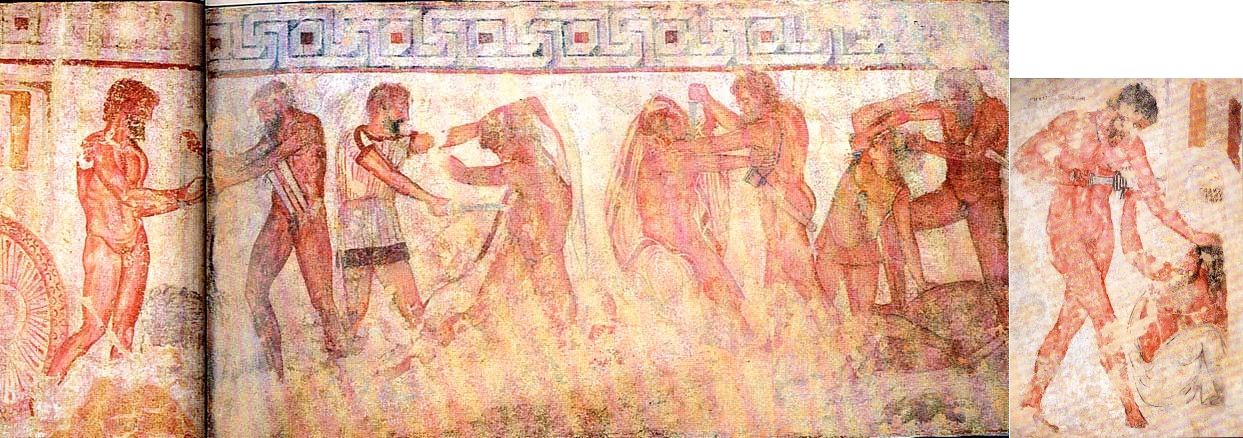|
Aes Equestre
The aes equestre was an allotment paid during the Roman Republic to each cavalryman to provide him with a horse. This was said to have been instituted by Servius Tullius as part of his reorganization of the military. This allotment was 10,000 As (Roman coin), asses, to be given to the Equus publicus out of the public treasury (ex publico) of Rome. A similar allotment, the aes hordearium paid for the horses' upkeep, and was funded by a tax of 2,000 ases annually on unmarried women and orphans possessing a certain amount of property Some say the equites had a right to distrain for this money likewise, it seems impossible that this account can be correct; for we can hardly conceive that a private person had a right of distress against a magistrate, that is, against the state, or that he could distrain any of the public property of the state. It is more probable that, since this money was paid by the single women and orphans, that it was against these that the equites had the same righ ... [...More Info...] [...Related Items...] OR: [Wikipedia] [Google] [Baidu] |
Roman Republic
The Roman Republic ( la, Res publica Romana ) was a form of government of Rome and the era of the classical Roman civilization when it was run through public representation of the Roman people. Beginning with the overthrow of the Roman Kingdom (traditionally dated to 509 BC) and ending in 27 BC with the establishment of the Roman Empire, Rome's control rapidly expanded during this period—from the city's immediate surroundings to hegemony over the entire Mediterranean world. Roman society under the Republic was primarily a cultural mix of Latin and Etruscan societies, as well as of Sabine, Oscan, and Greek cultural elements, which is especially visible in the Roman Pantheon. Its political organization developed, at around the same time as direct democracy in Ancient Greece, with collective and annual magistracies, overseen by a senate. The top magistrates were the two consuls, who had an extensive range of executive, legislative, judicial, military, and religious powers ... [...More Info...] [...Related Items...] OR: [Wikipedia] [Google] [Baidu] |
Servius Tullius
Servius Tullius was the legendary sixth king of Rome, and the second of its Etruscan dynasty. He reigned from 578 to 535 BC. Roman and Greek sources describe his servile origins and later marriage to a daughter of Lucius Tarquinius Priscus, Rome's first Etruscan king, who was assassinated in 579 BC. The constitutional basis for his accession is unclear; he is variously described as the first Roman king to accede without election by the Senate, having gained the throne by popular and royal support; and as the first to be elected by the Senate alone, with support of the reigning queen but without recourse to a popular vote. Several traditions describe Servius' father as divine. Livy depicts Servius' mother as a captured Latin princess enslaved by the Romans; her child is chosen as Rome's future king after a ring of fire is seen around his head. The Emperor Claudius discounted such origins and described him as an originally Etruscan mercenary, named Mastarna, who fought for Caeliu ... [...More Info...] [...Related Items...] OR: [Wikipedia] [Google] [Baidu] |
As (Roman Coin)
The ' (plural '), occasionally ''assarius'' (plural ''assarii'', rendered into Greek as , ''assárion'') was a bronze, and later copper, coin used during the Roman Republic and Roman Empire. Republican era coinage The Romans replaced the usage of Greek coins, first by bronze ingots, then by disks known as the aes rude. The system thus named ''as'' was introduced in ca. 280 BC as a large cast bronze coin during the Roman Republic. The following fractions of the were also produced: the (), (), (), (), (), (), (, also a common weight unit), and (), as well as multiples of the ''as'', the (2), (2), and (3) After the ''as'' had been issued as a cast coin for about seventy years, and its weight had been reduced in several stages, a ''as'' was introduced (meaning that it weighed one-sixth of a pound). At about the same time a silver coin, the denarius, was also introduced. Earlier Roman silver coins had been struck on the Greek weight standards that facilitated their ... [...More Info...] [...Related Items...] OR: [Wikipedia] [Google] [Baidu] |
Equus Publicus
The ''equus publicus'' (literally "horse bought by the commonwealth") was an honourable status in ancient Rome, granting its holder a military horse paid for by the state, along with the cost of its fodder for its whole life. The money for the horse was called '' aes equestre'', whilst the annual money for the horse's provisions for a year was called ''aes hordearium''. History ''Equus publicus'' was originally given to all members of the equites class, which was drawn from the patricians, in the regnal period. During the republican period, while the status of equites was obtainable by way of having a property value of more than 100,000 denarii or else inheritance, but the ''equus publicus'' was only attainable by way of inheritance from a father. In imperial times, after the reforms of Augustus, the status could be granted by an emperor, along with inheritance from a father.Jones (1964) 7, 8 See also * Social class in ancient Rome Social class in ancient Rome was hierarchical ... [...More Info...] [...Related Items...] OR: [Wikipedia] [Google] [Baidu] |
Aes Hordearium
The aes hordearium was an annual allotment of 2000 asses paid during the Roman Republic to an equus publicus for his military horse's upkeep. This money was paid by single women, which included both maidens and widows (''viduae''), and orphans (''orbi''), provided they possessed a certain amount of property, on the principle, as Barthold Georg Niebuhr remarks, "that in a military state, the women and children ought to contribute for those who fight in behalf of them and the commonwealth; it being borne in mind, that they were not included in the census." The equites The ''equites'' (; literally "horse-" or "cavalrymen", though sometimes referred to as "knights" in English) constituted the second of the property-based classes of ancient Rome, ranking below the senatorial class. A member of the equestrian o ... had a right to distrain ('' pignoris capio'') if the aes hordearium was not paid. References Attribution Taxation in ancient Rome {{AncientRome-stub ... [...More Info...] [...Related Items...] OR: [Wikipedia] [Google] [Baidu] |
University Of Chicago
The University of Chicago (UChicago, Chicago, U of C, or UChi) is a private research university in Chicago, Illinois. Its main campus is located in Chicago's Hyde Park neighborhood. The University of Chicago is consistently ranked among the best universities in the world and it is among the most selective in the United States. The university is composed of an undergraduate college and five graduate research divisions, which contain all of the university's graduate programs and interdisciplinary committees. Chicago has eight professional schools: the Law School, the Booth School of Business, the Pritzker School of Medicine, the Crown Family School of Social Work, Policy, and Practice, the Harris School of Public Policy, the Divinity School, the Graham School of Continuing Liberal and Professional Studies, and the Pritzker School of Molecular Engineering. The university has additional campuses and centers in London, Paris, Beijing, Delhi, and Hong Kong, as well as in downtown ... [...More Info...] [...Related Items...] OR: [Wikipedia] [Google] [Baidu] |
Equites
The ''equites'' (; literally "horse-" or "cavalrymen", though sometimes referred to as "knights" in English) constituted the second of the property-based classes of ancient Rome, ranking below the senatorial class. A member of the equestrian order was known as an ''eques'' (). Description During the Roman kingdom and the first century of the Roman Republic, legionary cavalry was recruited exclusively from the ranks of the patricians, who were expected to provide six ''centuriae'' of cavalry (300 horses for each consular legion). Around 400BC, 12 more ''centuriae'' of cavalry were established and these included non-patricians (plebeians). Around 300 BC the Samnite Wars obliged Rome to double the normal annual military levy from two to four legions, doubling the cavalry levy from 600 to 1,200 horses. Legionary cavalry started to recruit wealthier citizens from outside the 18 ''centuriae''. These new recruits came from the first class of commoners in the Centuriate Assembly orga ... [...More Info...] [...Related Items...] OR: [Wikipedia] [Google] [Baidu] |



